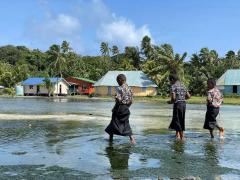-With Pacific nations facing some of the worst effects of climate change in the world, New Zealand is preparing to change the way it gives aid to its partners so they have more say in how, and where, money is spent.
The Government is set to give Pacific nations greater control over the climate change aid they receive from New Zealand, in a new “high-trust model” being rolled out for several countries.
A briefing to Foreign Affairs Minister Nanaia Mahuta in October last year proposed the establishment of a “country flexible finance” mechanism, with Pacific nations given climate aid directly to allocate themselves, rather than connected to specific projects as at present.
The Pacific’s annual climate financing needs had been estimated at roughly US$1 billion per year, or up to nine percent of the region’s GDP, with current levels of funding falling well short at just US$220 million a year.
“For Pacific countries to become low emissions, climate resilient societies, a significant scale up of their ability to access, receive and deliver climate finance is required.
“It also requires a change in the way donor partners administer and release funding to reduce the administrative burden on Pacific countries.”
While Pacific nations had called for greater autonomy to deliver on their own climate change priorities, they faced a number of challenges, such as turning high-level plans into investment ready-proposals, securing technical advice, and overly burdensome processes to access finance.
“Pacific public sectors also face challenges, particularly in having robust systems to receive, deliver and report on climate finance. These challenges are inhibiting their ability to scale up their responses to climate change.”
Under the flexible finance proposal, all Pacific nations would be given support to become more capable of receiving climate finance by strengthening their public finance and national planning systems.
They would also receive help to develop multi-year investment pipelines to improve the planning and sequencing of their climate priorities and meet their nationally determined contribution (NDC) targets as agreed through the Paris climate deal.
While some Pacific countries would already be able to receive money through the new mechanism, others would need more time to strengthen their internal processes.
“For these countries we would look at alternative ways to improve the predictability and flexibility of how we provide climate finance, as best suits the country’s context and our approach to risk management,” the briefing said.
The Government would not take a “one size fits all” approach, instead tailoring plans for each country based on their ability to receive, manage and report on climate finance.
New Zealand would also encourage other funding partners to take a similar approach in the Pacific, or to join the government mechanism.
The briefing raised a number of risks with the proposal, including the possibility that some Pacific nations fail to increase their overall investment in climate resilience and instead divert domestic funds elsewhere.
It also noted the threat of ‘elite capture’, with climate spending priorities set by “actors in partner countries who are not representative of broader community interests”, as well as Pacific governments potentially lacking the technical skills or public sector capacity necessary to deliver the climate finance.
However, officials said the funding tool would “incentivise the mainstreaming of climate resilience across all public expenditure”, and would include money for community engagement as well as management and planning reforms.
Given the size and complexity of the plan, officials would take a sequential approach to its design and implementation.
In a written statement, Mahuta confirmed to Newsroom the Government was moving ahead with the concept.
The plan meshed with New Zealand’s overall approach to international climate finance, as well as its Pacific resilience strategy given the emphasis on greater autonomy and flexibility.
“Partner governments can decide whether to use it for emissions reductions – such as renewable energy, or energy efficiency projects – or for a wide range of adaptation action, from building resilience to extreme weather events, or adapting gardens and crops to rising temperatures, or increasing coastal resilience to rising sea levels.”
Mahuta said New Zealand had already made allocations of flexible finance to Samoa, Tonga and the Cook Islands, with officials working with its Pacific partners to determine governance arrangements for the delivery of the funding.
SOURCE: NEWSROOM/PACNEWS














